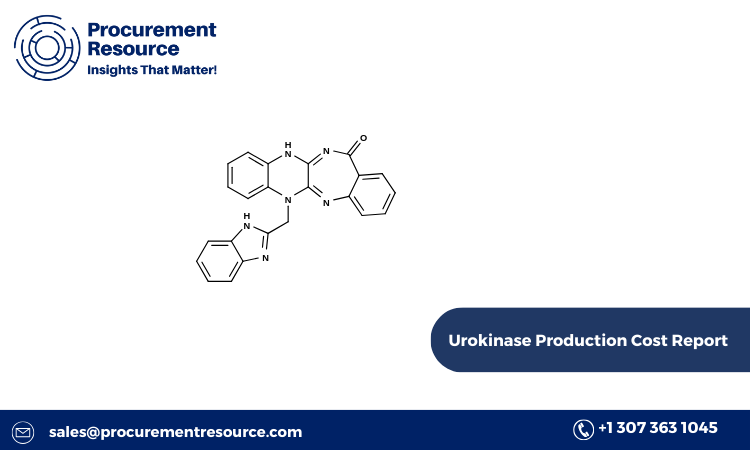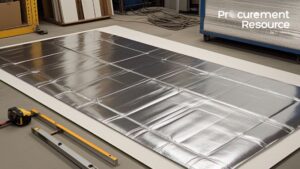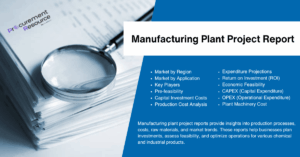
Urokinase, a thrombolytic agent, plays a critical role in the medical field, primarily used for dissolving blood clots in patients suffering from conditions such as pulmonary embolism and deep vein thrombosis. As a potent enzyme, urokinase catalyzes the conversion of plasminogen to plasmin, which in turn breaks down fibrin, the main protein component of blood clots. The increasing demand for effective thrombolytic therapies has led to a growing focus on the efficient and cost-effective production of urokinase. This blog post delves into the intricate details of the urokinase production process, exploring the manufacturing methods, raw material costs, and the latest developments in this field.
Manufacturing Report and Process
The production of urokinase is a complex and highly specialized process that involves several critical stages. The enzyme is naturally found in human urine, but for commercial production, the process typically starts with the extraction and purification of the enzyme from cell cultures, particularly from human kidney cells or recombinant microbial systems.
Request For Sample: https://www.procurementresource.com/production-cost-report-store/urokinase/request-sample
- Cell Culture and Fermentation:
- The initial phase of urokinase production involves cultivating human kidney cells or genetically modified microorganisms, such as E. coli, that have been engineered to express the urokinase enzyme. The cells are grown in a controlled environment with optimal conditions for growth, such as temperature, pH, and nutrient supply.
- During fermentation, the cells are allowed to proliferate, and as they grow, they produce urokinase in significant quantities. This stage is crucial as it determines the overall yield and efficiency of the production process.
- Harvesting:
- Once a sufficient amount of urokinase is produced, the cells are harvested. In the case of microbial systems, this usually involves centrifugation to separate the cells from the fermentation broth. For human kidney cells, the process may involve filtration or other separation techniques.
- The harvested cells are then subjected to lysis, a process that breaks down the cell membrane to release the intracellular urokinase. The crude extract obtained from this step contains urokinase along with other cellular components.
- Purification:
- The crude extract undergoes a series of purification steps to isolate urokinase from other proteins and impurities. This is typically achieved through chromatographic techniques such as ion-exchange chromatography, affinity chromatography, and gel filtration. The goal is to obtain urokinase with high purity and activity.
- The purification process is critical as it directly impacts the quality and efficacy of the final product. Stringent quality control measures are implemented to ensure that the urokinase produced meets the required standards for medical use.
- Formulation and Stabilization:
- After purification, the urokinase is formulated into a stable form suitable for storage and administration. This may involve lyophilization (freeze-drying) to produce a powder that can be reconstituted before use or the preparation of a liquid formulation with stabilizing agents to maintain the enzyme’s activity over time.
- The final product is then subjected to rigorous testing to ensure its safety, efficacy, and stability. This includes assays to confirm the enzyme’s activity, sterility testing, and checks for any potential contaminants.
- Packaging:
- The last stage in the production process involves packaging the urokinase in vials or ampoules under sterile conditions. The packaging process is designed to preserve the enzyme’s integrity and ensure that it remains effective until it is administered to patients.
Raw Material Costs
The cost of raw materials is a significant factor in the overall economics of urokinase production. The primary raw materials involved in the production process include:
- Cell Culture Media:
- The cultivation of human kidney cells or recombinant microorganisms requires specialized culture media that provide the necessary nutrients for cell growth. These media are typically composed of amino acids, vitamins, salts, glucose, and growth factors. The quality and composition of the media can greatly influence the yield and quality of urokinase.
- High-quality culture media can be expensive, but they are essential for achieving optimal cell growth and enzyme production.
- Reagents for Purification:
- The purification of urokinase requires various reagents and materials, including chromatography resins, buffers, and solvents. These reagents must be of high purity to ensure the efficient separation of urokinase from impurities.
- The cost of these reagents can be substantial, particularly for large-scale production, where significant quantities are needed.
- Stabilizers and Excipients:
- To maintain the stability and activity of urokinase during storage, stabilizers and excipients are added to the final formulation. These may include sugars, salts, and other compounds that help preserve the enzyme’s structure and function.
- The selection of stabilizers and excipients is critical, as they must be compatible with urokinase and safe for use in medical applications.
- Packaging Materials:
- The final product must be packaged in a way that protects it from contamination and degradation. This requires the use of high-quality packaging materials, such as sterile vials, ampoules, and seals.
- Packaging costs are an important consideration, especially in the context of large-scale production, where economies of scale can play a role in reducing overall costs.
Latest News
The production of urokinase has seen significant advancements in recent years, driven by ongoing research and development in biotechnology and pharmaceutical manufacturing. Some of the latest developments in the field include:
- Recombinant Production Advances:
- The use of recombinant DNA technology has revolutionized urokinase production. Recent advancements in genetic engineering have enabled the development of more efficient microbial strains that can produce urokinase in higher yields. This has reduced the reliance on human kidney cells, leading to more scalable and cost-effective production processes.
- Improved Purification Techniques:
- Innovations in chromatography and other purification techniques have led to higher purity urokinase products with reduced production costs. New resins and affinity tags are being developed to enhance the efficiency of purification processes, making them more suitable for large-scale production.
- Regulatory Approvals and Market Expansion:
- The approval of new urokinase formulations by regulatory agencies such as the FDA and EMA has expanded the market for this critical enzyme. These approvals are often accompanied by clinical data demonstrating the safety and efficacy of the product, which can drive adoption in new markets.
- Additionally, the growing incidence of thromboembolic disorders worldwide is increasing the demand for urokinase, leading to further investments in production capacity and research.
- Collaborations and Partnerships:
- Pharmaceutical companies are increasingly forming collaborations and partnerships to share expertise and resources in urokinase production. These partnerships often focus on optimizing production processes, reducing costs, and expanding the availability of urokinase to meet global demand.
In conclusion, the production of urokinase is a sophisticated process that requires careful consideration of various factors, including raw material costs, manufacturing techniques, and the latest advancements in biotechnology. As the demand for effective thrombolytic therapies continues to grow, the production of urokinase is likely to see further innovations and improvements, ensuring its availability for patients in need.






